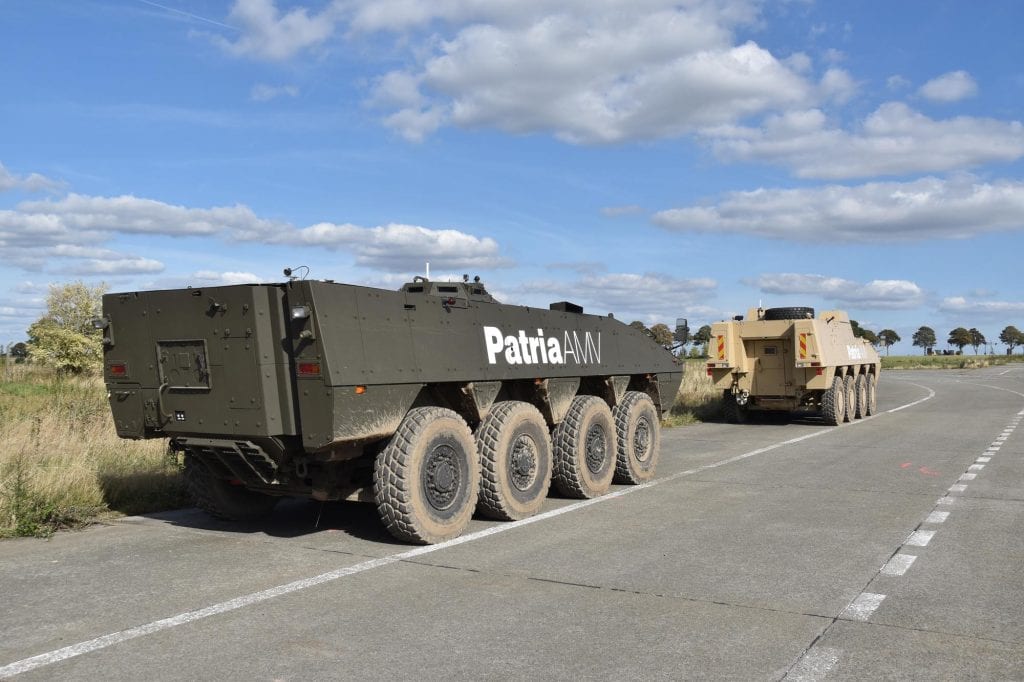Patria details development of unmanned vehicles for support and combat missions
Posted on
Finland’s Patria gave further details of the development of the new unmanned vehicles for reconnaissance, support and combat missions on Patria AMV 8×8 bases.
According to a company’s statement, autonomy and remote use of vehicles are a hot topic in the defense sector around the world. In this connection, it was decided to develop unmanned solutions in the family of AMV vehicles.
An international test has proven Patria a pioneer in the development of unmanned vehicles. The full digitalised Patria AMV attracted a lot of positive attention at the European Land Robot Trial (ELROB) event in Belgium in September 2018.
“The fully digitalised Patria AMV, which forms part of the Patria AMV 8×8 product range, received a great deal of positive attention at the event,” says Matti Saarikko, Director, Technology Management, of the Patria’s Land business unit.
At the ELROB event, an impartial jury assessed the level of various technological solutions in everyday challenges. Patria competed in the category in which the capability of unmanned military vehicles was tested in convoy missions. The remote controlled vehicle had to follow a command vehicle autonomously.
“The testing took place under realistic conditions. The 2.4 kilometre route included slippery country roads, for example,” says Saarikko.
However, Saarikko was yearning for a more challenging test track. He points out that this would have highlighted the good qualities of the Patria vehicle even more effectively.
“The positive feedback from the impartial jury showed that we have developed a credible alternative among unmanned vehicles. Patria’s solution is already close to being the right kind of product that the customer can use.”

A strong impression was also made by the flexibility of Patria’s option.
“The integrated drive-by-wire control system developed by Patria enables both remote control of a vehicle and autonomous functions. It also allows traditional, manned use of the vehicle.
As one of the benefits of the Patria system, Saarikko also notes that, in addition to the new vehicles, the autonomous function can be integrated into all existing Patria AMV vehicles. More than 1,600 of these are in use by the Defence Forces of various countries.
Matti Saarikko reminds us that a long development effort lies behind the Patria vehicle which succeeded at ELROB.
“A high-performance vehicle forms the basis of the entire project. In addition, a remotely controlled system is needed in place of the driver.”
The system is supported by a sensor system based on lasers, cameras and radar. Inertia and GPS positioning are also required in order to control the vehicle.
According to Saarikko, the development of unmanned military vehicles has many similarities to that of driverless cars. However, the challenges are different.
“The control of military vehicles cannot rely on infrastructure such as lane markings on roads. In addition, the system must operate in all circumstances, including in darkness and fog.”

Janne Räkköläinen, Vice-President, Vehicle Systems, says that the autonomy and remote use of vehicles are among the key, future capabilities aimed at improving soldiers’ prospects of survival. They enable new operational functions and allow the use of vehicles in various missions and locations without placing the crew at risk.
“Progress towards fully autonomous vehicles is progressing in stages. The next step is the combined use of manned and unmanned vehicles. In this way, experiences and the development of systems and operations can be gained before shifting to fully autonomous systems,” explains Räkköläinen.
He believes that ELROB was very effective in highlighting the latest focuses of product development. The tasks for the event were created in close collaboration with military users and reflected the latest user requirements.
“We have engaged in a lot of spontaneous development, which has deepened our expertise. The work will continue and we still intend to participate in a broader range of research and development projects, together with other countries and companies, under the European Defence Organisation (EDA) and the European Defence Fund (EDF).
Räkköläinen points out that this is not just about individual vehicles, but that users are considering the wider application of new technologies in the development of operational practices.
“Close dialogue with customers is important to gaining an understanding of customer’s needs. On the other hand, customers also gain insights into development paths and technologies. This enables them to better develop new practices and operational concepts.”
Subscribe to our newsletter
Promotions, new products and sales. Directly to your inbox.
